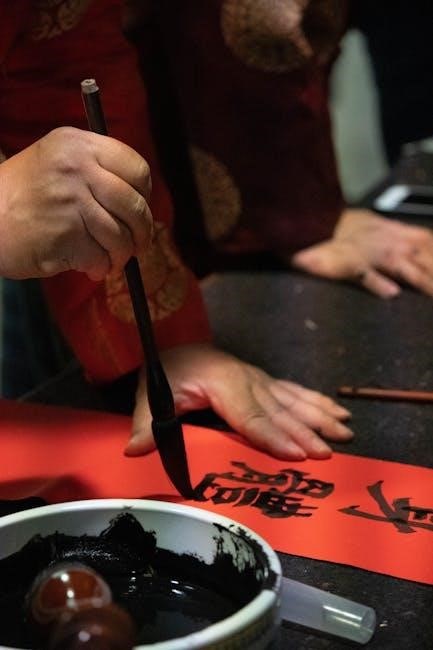Solfege hand signs are visual gestures representing musical notes, aiding pitch recognition and rhythm.
They enhance music education and practice, used by educators and musicians worldwide.
What Are Solfege Hand Signs?
Solfege hand signs are visual gestures linked to musical notes, aiding pitch recognition and rhythm.
They represent syllables like do, re, mi, fa, sol, la, and ti, with specific hand shapes.
Developed by Curwen and refined by Kodály, these signs help internalize pitch relationships.
They are tools for music education, enhancing vocal technique and expression.
Hand signs provide a physical connection to sound, making learning interactive and engaging.
They are widely used in classrooms and performances, fostering musical understanding and memory.
Creating a Solfege hand signs PDF allows easy access to these gestures for practice and reference.
The Importance of Solfege in Music Education
Solfege hand signs are a cornerstone of music education, enhancing pitch recognition, memory, and vocal technique.
They provide a visual and kinesthetic connection to musical notes, making learning interactive.
By associating syllables (do, re, mi, fa, sol, la, ti) with gestures, students internalize pitch relationships.
This system bridges theory and practice, fostering a deeper understanding of music.
Hand signs are particularly valuable for young learners, as they simplify complex concepts.
They also serve as a universal language, transcending cultural and linguistic barriers.
Educators worldwide use Solfege to build foundational skills, preparing students for advanced musical pursuits.
Creating a Solfege hand signs PDF ensures accessibility, making these tools available for practice and reference.
History and Development of Solfege Hand Signs
The Curwen and Glover hand signs laid the foundation, later refined by the Kodály approach, creating a universal system for music education and pitch recognition.
The Curwen and Glover Hand Signs
The Curwen hand signs, developed by John Curwen, laid the groundwork for modern solfege systems.
They associate specific gestures with syllables like do, re, mi, fa, sol, la, and ti.
These signs help musicians visualize and internalize pitches, enhancing vocal technique and pitch recognition.
Glover further refined this system, ensuring clarity and consistency in music education.
Together, their work established a foundational tool for teaching musical notation and pitch relationships.
Their hand signs remain widely used, particularly in educational settings, to bridge the gap between auditory and visual learning.
The Kodály Approach and Its Influence
The Kodály approach, developed by Zoltán Kodály, emphasizes the use of solfege hand signs to teach musical literacy.
It integrates rhythm, pitch, and movement, making music education engaging and accessible.
Kodály believed in the importance of solfege for internalizing musical concepts, particularly for children.
His method popularized the association of hand signs with syllables like do, re, mi, fa, sol, la, and ti.
This approach has globally influenced music education, fostering a deeper connection between visual, auditory, and kinesthetic learning.
By linking gestures to pitches, the Kodály method helps musicians develop precise pitch recognition and musical expression.
Its legacy continues to shape modern teaching practices, ensuring solfege hand signs remain a vital educational tool.

Benefits of Using Solfege Hand Signs
Solfege hand signs enhance pitch recognition, memory, and vocal technique.
They provide a visual and kinesthetic connection to musical notes, making learning engaging and effective for musicians of all levels.
Enhancing Pitch Recognition and Memory
Solfege hand signs link specific gestures to musical pitches, aiding in pitch recognition and memory.
By associating notes with physical movements, musicians internalize scales and intervals more effectively.
The visual and kinesthetic connection strengthens memory, making it easier to recall pitches and melodies.
Regular practice with hand signs improves pitch accuracy and enhances overall musical understanding.
Improving Vocal Technique and Expression
Solfege hand signs enhance vocal technique by providing a physical connection to pitch placement.
This visual and kinesthetic link helps singers produce accurate notes with better control and expression.
By associating gestures with specific pitches, musicians develop stronger vocal precision and intonation.
Regular practice with hand signs fosters a deeper understanding of pitch relationships, leading to more expressive performances.

The Structure of Solfege Hand Signs
Solfege hand signs follow a structured system, with each gesture corresponding to specific syllables.
Basic signs represent do, re, mi, fa, sol, la, and ti, arranged to reflect pitch progression.
Basic Solfege Syllables and Their Corresponding Hand Signs
The basic solfege syllables—do, re, mi, fa, sol, la, and ti—each have distinct hand signs.
Do begins at mid-chest level, with arms relaxed.
Re extends one hand slightly higher.
Mi is formed with both hands at shoulder height.
Fa drops one hand lower.
Sol raises both arms overhead.
La lowers one arm slightly.
Ti returns to a high, small gesture.
These signs help musicians internalize pitch and rhythm, making them essential for vocal and instrumental training.
Extended Solfege Syllables for Advanced Musicians
Advanced solfege includes extended syllables like di, ri, and others for chromatic pitches.
These signs build on basic gestures, adding complexity for altered notes.
For example, di raises the little finger for a raised first pitch.
Ri extends the thumb for a lowered second pitch.
These extensions help musicians navigate complex melodies and intervals.
They are particularly useful for sight-singing and understanding chromaticism.
Including these in a PDF guide provides a comprehensive resource.
Diagrams and explanations clarify each gesture.
Practicing extended syllables enhances mastery of advanced musical concepts.
They bridge the gap between basic and professional-level solfege skills.
Creating a Solfege Hand Signs PDF
Creating a solfege hand signs PDF involves using design tools like Adobe or Canva.
Include diagrams, explanations, and exercises for practical learning and reference.
Designing and Formatting Your PDF
Designing a solfege hand signs PDF requires careful layout and formatting.
Use software like Adobe or Canva to create visually appealing diagrams and clear instructions.
Ensure the hand signs are illustrated with accuracy and precision.
Include high-quality images or illustrations of each hand sign.
Add explanations for proper finger placement and alignment.
Use consistent fonts and colors to maintain a professional appearance.
Organize content logically, starting with basic syllables and progressing to advanced ones.
Consider adding practice exercises and examples for users to follow.
Make sure the PDF is easy to navigate and print-friendly.
Incorporate a legend or key to explain the symbols and gestures used.
Including Visual Examples and Explanations
Including visual examples and explanations in your solfege hand signs PDF is essential for clarity.
Use high-quality images or diagrams to illustrate each hand sign accurately.
Add captions or labels to explain the corresponding solfege syllables and pitches.
Provide step-by-step instructions for each gesture, highlighting proper finger placement.
Include examples of how the hand signs align with musical scales or songs.
Use arrows or symbols to indicate movement or direction for complex signs.
Consider adding side-by-side comparisons of hand signs with staff notation.
Offer tips for practicing the signs and integrating them into singing or playing instruments.
Ensure the visuals are large enough to be easily visible when printed.

Practical Applications of Solfege Hand Signs
Solfege hand signs are practical tools for teaching pitch recognition and enhancing musical performances.
They aid in visualizing scales and harmonies, making complex music more accessible.
Using Hand Signs in Classroom Settings
Solfege hand signs are a powerful tool in music education, helping students connect musical notes with physical gestures.
Teachers use these signs to enhance pitch recognition, rhythm, and vocal technique in an engaging way.
In classroom settings, hand signs create a visual and kinesthetic learning experience.
They simplify complex musical concepts, making them accessible to students of all ages and skill levels.
By incorporating hand signs into lessons, educators foster active participation and teamwork.
This method aligns with the Kodály approach, emphasizing the importance of movement in musical development.
Free printable PDFs of solfege hand signs are widely available, providing teachers with ready-to-use resources.
These tools support interactive activities, ensuring a dynamic and effective learning environment.

Integrating Hand Signs into Musical Performances
Solfege hand signs add a visual and engaging dimension to musical performances, enhancing audience connection.
They allow performers to express pitch and rhythm through movement, creating a dynamic experience.
Choirs and ensembles often incorporate hand signs during songs, providing a unified and polished presentation.
This practice strengthens performers’ understanding of musical structure and pitch relationships.
Hand signs also help performers internalize melodies and harmonies, improving accuracy and expression.
They can be synchronized with choreography, adding an artistic layer to the performance.
Free PDF guides offer detailed instructions for integrating hand signs into performances, ensuring consistency and precision.
This approach makes musical presentations more engaging and meaningful for both participants and audiences.

Resources for Learning Solfege Hand Signs
Free printable Solfege Hand Signs PDFs and guides are widely available online, offering visual examples and step-by-step instructions.
Online tutorials and video demonstrations further enhance learning and practice.

Free Printable PDFs and Guides

Free printable Solfege Hand Signs PDFs are widely available online, offering comprehensive guides for musicians and educators.
These resources include detailed diagrams, step-by-step instructions, and exercises to practice hand signs.
Many PDFs feature the Curwen and Glover hand signs, aligning with the Kodály method.
They often include visual examples for each solfege syllable (do, re, mi, fa, sol, la, ti) and their corresponding gestures.
Some guides also provide exercises for singing and hand sign coordination, making them ideal for classroom use or self-study.
Popular platforms like Pinterest and educational websites offer these PDFs for easy download.
These resources are invaluable for musicians seeking to enhance pitch recognition and vocal technique through solfege hand signs.
Online Tutorials and Video Demonstrations
Online tutorials and video demonstrations are excellent resources for mastering Solfege hand signs.
Platforms like YouTube and educational websites offer step-by-step guides and practical exercises.
These videos often include visual demonstrations of each hand sign, synchronized with solfege syllables.
They also provide tips for integrating hand signs into singing and music practice.
Many tutorials are designed for both beginners and advanced musicians, covering basic and extended solfege syllables.
Some videos feature interactive lessons, allowing viewers to practice along with instructors.
These digital tools make learning solfege hand signs accessible and engaging for anyone with an internet connection.
They are particularly useful for self-study and remote music education.
Cultural and Global Impact of Solfege Hand Signs
Solfege hand signs have been adopted globally, integrating into diverse music traditions.
Their universal appeal enhances music education worldwide, with PDF resources aiding their widespread dissemination and cultural adaptation.
Adoption in Different Countries and Music Traditions
Solfege hand signs have been embraced globally, with diverse cultures adapting them to their musical practices.
From classical music in Europe to folk traditions in Asia, their universal appeal fosters musical understanding.
In the U.S. and U.K., educators integrate them into school curriculums, while in Hungary, the Kodály method popularized their use.
Similarly, Latin American countries incorporate hand signs into choral and instrumental training.
This adaptability highlights their effectiveness in bridging cultural and linguistic barriers, making them a cornerstone of global music education.
PDF resources further facilitate their dissemination, ensuring accessibility for musicians worldwide.
Modern Innovations and Digital Tools

Modern innovations have transformed the accessibility and engagement of solfege hand signs through digital tools.
PDF guides and interactive apps now offer visual and auditory aids, enhancing learning experiences.
Online tutorials and animations demonstrate hand signs in real-time, catering to diverse learning styles.
Digital platforms also provide printable resources, making solfege hand signs widely accessible.
These tools bridge traditional methods with contemporary technology, ensuring the longevity of solfege in music education.
By integrating digital media, solfege hand signs remain relevant and engaging for new generations of musicians and educators worldwide.

Conclusion
Solfege hand signs remain a timeless and versatile tool in music education, offering a bridge between traditional methods and modern innovations, ensuring their continued relevance for musicians worldwide.
Final Thoughts on the Value of Solfege Hand Signs
Solfege hand signs are a timeless and invaluable tool in music education, bridging the gap between auditory and visual learning.
They not only enhance pitch recognition but also foster a deeper connection to musical expression.
By providing a physical representation of sound, these gestures empower musicians to internalize melodies and rhythms more effectively.
Their adaptability across cultures and educational settings underscores their universal appeal.
As music evolves, solfege hand signs remain a cornerstone, offering a tangible link between tradition and innovation.
They continue to inspire and educate, ensuring their relevance for future generations of musicians and educators alike.
Encouragement to Explore and Practice
Exploring solfege hand signs is a rewarding journey that enhances musical understanding and expression.
Begin by practicing basic syllables like do, re, mi, fa, sol, la, and ti, gradually incorporating hand gestures.
Utilize free printable PDFs and online guides to refine your technique.
Consistent practice strengthens pitch recognition and vocal accuracy, making music more accessible and enjoyable.
Whether you’re a student or educator, solfege hand signs offer a versatile tool for learning and teaching.
Embrace this timeless method to deepen your connection with music and unlock new creative possibilities.
Remember, every practice session brings you closer to mastering this invaluable skill.
